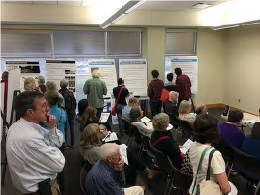By Mike Zelek, MPH, Division Director, Health Promotion and Policy, Chatham County Public Health Department
Planning for public health seems to be all the rage these days, with public health practitioners engaging partners from a range of sectors in hopes of finally making progress on those hard-to-change issues like obesity. At the Chatham County Public Health Department in North Carolina, we have bought into the Health in All Policies (HiAP) approach to public health, and we believe that policy solutions are key to population-level change, both in terms of health outcomes and health equity.
While we have worked with local planning departments for years, beginning in 2013 with a local Pedestrian Master Plan that was the first of its kind to consider access to healthy foods, we had long viewed a countywide comprehensive plan as a golden opportunity to weave health into the fabric of our community for years to come. When the county commissioners approved the development of Chatham’s first comprehensive plan in 2016, this vision became reality.
Using grant funding from multiple sources, we worked with consultants and the Chatham County Planning Department to develop a health element as part of the plan, rooted in the county’s health priorities and with a focus on health equity. We looped in the Chatham County Board of Health and the Chatham Health Alliance, a coalition of local professionals and county residents working together to improve health outcomes, to provide expertise through a forum and smaller focus groups.
The resulting HiAP approach systematically considers the health implications of policy decisions with the aim of improving population health and health equity. As a first step, we included health data in the development of plan recommendations, such as healthy food access data gathered using the Chatham Food Vendor Survey, and additional data related to Chatham’s three health priorities: obesity, access to mental health services, and access to healthcare. Staff and steering committee members developed an outreach plan to gather community, policy maker, and stakeholder feedback in the development of the plan. The team then mapped factors that contribute to overall health to identify public health priority areas, or county locations with greater needs based on health and socioeconomic indicators.
The final plan includes this innovative HiAP approach with the following “big idea,” or overarching theme, for the health element: “Assure effective integration of health, healthcare, and equity in Chatham’s plans, programs, projects, and policies.” This approach also yielded a new plan goal, “foster a healthy community,” and embedded policy and project recommendations with direct ties to heath and equity across plan elements, from adequate and affordable housing to open spaces and employment opportunities. The recommendations in the health element seek to foster continued partnership to institutionalize a HiAP approach, targeting the social determinants of health as a mechanism to improve health equity and address community needs around identified health priorities.
Beyond the overarching goals and big ideas related to health in the plan, the plan lays out several specific policies and strategies to improve health, particularly among populations at greater risk of adverse health outcomes. For example, the health element recommends establishing “a framework for guiding public and private investments so the end results are environments that are conducive to healthier living,” with specific strategies and considerations to carry this out, such as housing diversity, multigenerational neighborhoods, and safe access to schools and public facilities. Another example relates to transportation, as many residents with limited transportation find it difficult to access health-promoting resources and healthcare services. The plan analyzed current access to healthcare across the county, including hospitals, emergency rooms, and urgent care centers. This analysis yielded recommendations of where additional services could be located to target populations with limited transportation and healthcare facilities.
The plan’s emphasis on equity, HiAP, and inclusion of a range of innovative policy recommendations targeting the diverse factors that affect health will make it a valuable reference for counties going through similar processes. Furthermore, its focus on the health priorities established in the Community Health Assessment creates synergy across sectors while unifying efforts to address poor health outcomes. This approach to planning is applicable for communities like Chatham that face challenges in providing equitable access to resources across diverse geographic settings. This plan provides strategies to overcome geographic barriers to better health outcomes and identifies the “who” and “how” for recommended programs, policies, and projects, making the HiAP elements generalizable to both rural and urban settings.
Finally, as this plan is finalized and the recommended strategies begin to be implemented, Chatham is embarking on a novel approach to monitor the impact of these strategies through a community-based cohort assessment. In early 2018, we recruited a random sample of county residents and will follow them over time to assess needs, preferences, and outcomes related to health and social determinants. This approach purposely coincides with the adoption of the plan and will yield important insight and ongoing community input as policies from the plan are enacted. It is also part of our revamped Community Assessment process, which is the first we are aware of that uses a cohort approach. We hope that this approach will give us a better ongoing understanding of the community, and could even be useful in identifying emerging health threats or post-disaster communication, as it is based on the Community Assessment for Public Health Emergency Response (CASPER) method for public health emergency response.
The strategies laid out in the plan will be critical as Chatham’s population doubles over the next 25 years, and relationships developed through the planning process with key stakeholders and policy makers will be vital as we begin to translate these strategies into action. With a HiAP approach embedded within the plan to guide this growth, we have made health a focal point of our community’s collective efforts and established the partnerships and future policies needed to carry out this vision.






